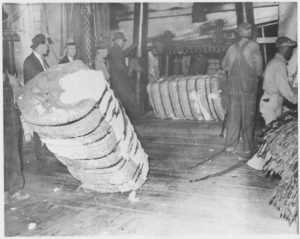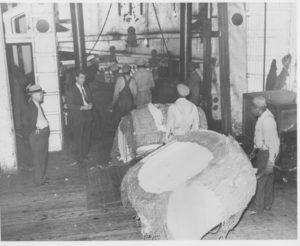Slowly but surely manufacturing and technology have overcome and then rapidly passed other industries, including agriculture. But we can never ignore the importance of the farmer and his workers. They still battle many of the same problems they faced at the beginning of time. This week I read an interesting article in Southwest Farm Press of 19 October 2017. It presented a positive outlook for cotton farmers, the source of wealth and misery for most of the south since Colonial times.
Today the four leading cotton-producing states are California, Arizona, New Mexico, and Texas. Of those, Texas is the largest producer in the country with two very fertile regions: South Texas with access to Gulf Coast shipping, and the High Plains of West Texas.
The world cotton production for 2017 is estimated near 121 million bales. Of those, about 21.8 million bales will be produced in the United States, mostly in those four states.
Until the late 19th century, cotton was raised and marketed by the same individual. As prices dropped, farmers joined forces to create Farmers’ Alliances with co-operative warehouses. They planned to hold their cotton until prices rose; but with heavy debts the cotton producers found that difficult. Their aims included a fair price for their hard work; fair return from all business partners including gins, compresses and warehouses; and the control of their own destinies. Today’s cotton producers aim for the same results.
Challenges facing the 21st century cotton farmer are the same as those a century or more ago. These include reducing costs on per pound basis; increasing volume in the co-op; determining warehouse capacity and distribution; as well as improving marketing the co-op’s capital position.

Cotton bales after compressed and tied. They are shipped to Galveston, loaded on a ship for use in England or France.
A new cotton gin recently went into operation north of Cooper in Delta County. A century ago, almost every crossroad had a gin where cottonseeds were separated from the cotton boll. Then the cotton was baled and sent to a compress; another operation found in larger communities. The one in Greenville managed to set a record in the fall of 1912 for the number of bales compressed in one day. Then the compressed bales were shipped to Galveston via railroad. There the cotton was loaded on ships bound for England and France. World War I disrupted the sale of cotton to European countries but in the U. S., cotton production continued.
There is one cotton field between Greenville and Royce City on Interstate 30. It hasn’t been picked yet, so it would be a good adventure for children. Eighteen wheel trucks with flat beds are sometimes seen driving along the interstate carrying very large rolls of cotton wrapped in bright yellow plastic. One would think they were going to a gin, but definitely to some form of marketing.
There was another positive article in the Southwest Farm Press. We’ve all heard of the boll weevil, or Anthonomus grandis, as it is scientifically known. Around 1900 this little varmint migrated from Mexico into the United States and created all kinds of problems. It was carried by the wind. Scientists, farm agents, and farmers battled the boll weevil scourge. Through their hard work and vigilance, the boll weevil is under control. For the farmers’ sake, lets hope it stays that way.


I haven’t seen any current figures but I am sure New Mexico is much farther down the list of producing states. I live 4 miles from NM and would bet that Arkansas, Mississippi and Alabama and several more southeastern and eastern states each produce more cotton than NM. The very large rolls of cotton wrapped in plastic (of at least 2 different colors) are going to a gin. Harversters with an on board round baler are slowly replacing the module builder. Your article is appreciated.